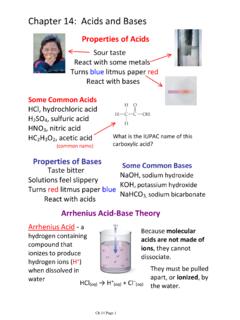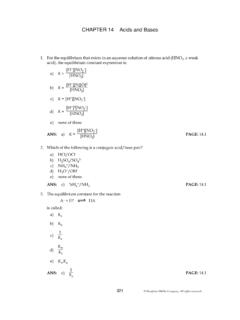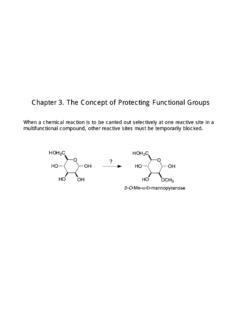Transcription of CHAPTER 14 REVIEW Acids and Bases - Weebly
1 Name Date Class _ CHAPTER 14 REVIEW Acids and Bases SHORT ANSWER Answer the following questions in the space provided. 1. a. Write the two equations that show the two-stage ionization of sulfurous acid in water. stage 1: H2S03(aq) + H20(/) ~ H30+(aq) + HSOi(aq) b. Which stage of ionization usually produces more ions? Explain your answer. Stage 1; for most polyprotic Acids , the concentration of ions formed in the first ionization is the greatest. 2. a. Define a Lewis base . Can OH-function as a Lewis base ? Explain your answer. A Lewis base is a species that donates an electron pair to form a covalent bond. Yes, OH -is a Lewis base .
2 It has an electron pair available to donate. For example, b. Define a Lewis acid . Can H+ function as a Lewis acid ? Explain your answer. A Lewis acid is a species that accepts an electron pair to form a covalent bond. H+ is a Lewis acid because it can accept an electron pair from a base . For example, 3. Identify the Brl1lnsted-Lowry acid and the Brl1lnsted-Lowry base on the reactant side of each of the following equations for reactions that occur in aqueous solution. Explain your answers. a. H20(1) + HN03(aq) ~ H30+(aq) + N03(aq) HN03 is the Bnmsted-Lowry acid because it donates a proton to the H20. The H20 is the Br"nsted-Lowry base because it is the proton acceptor.
3 B. HP(aq) + HS-(aq) ~ H2S(aq) + P-(aq) HF is the Brsnsted-Lowry acid because it donates a proton to the HS-. The HS-is the Br"nsted-Lowry base because it is the proton acceptor. MODERN CHEMISTRY Acids AND Bases 119 Copyright by Holt, Rinehart and Winston. All rights reserved. Name Date Class _ SECTION 2 continued 4. 3. Write the equation for the first ionization of H2C03 in aqueous solution. Assume that water serves as the reactant that attaches to the hydrogen ion released from the H2C03 Which of the reactants is the Brllinsted-Lowry acid , and which is the Brllinsted-Lowry base ? Explain your answer. H2C03 (aq) + H20(/) f7 HCOi(aq) + H30+(aq).
4 The H2C03 is the Br"nsted-Lowry acid because it donates a proton to the H20. The H20 is the Br"nsted-Lowry base because it accepts the proton. b. Write the equation for the second ionization, that of the ion that was formed by the H2C03 in the reaction you described above. Again, assume that water serves as the reactant that attaches to the hydrogen ion released. Which of the reactants is the Brllinsted-Lowry acid , and which is the Brllinsted-Lowry base ? Explain your answer. HCOi(aq) + H20(/) ~ CO~-(aq) + H30+(aq). The HCOi is the Br"nsted-Lowry acid because it donates a proton to the H20 is the Br"nsted-Lowry base because it accepts the proton.
5 C. What is the name for a substance, such as H2C03, that can donate two protons? a diprotic acid 5. 3. How many electron pairs surround an atom of boron (B, element 5) bonded in the compound BCl3? three b. How many electron pairs surround an atom of nitrogen (N, element 7) in the compound NF3? four c. Write an equation for the reaction between the two compounds above. Assume that they react in a l: 1 ratio to form one molecule as product. BCh + NF3 ~ BCI3 NF3 d. Assuming that the B and the N are covalently bonded to each other in the product, which of the reactants is the Lewis acid ? Is this reactant also a Brllinsted-Lowry acid ?
6 Explain your answers. BCI3 is the Lewis acid because it accepts an electron pair in forming a covalent bond. It is not a Br"nsted-Lowry acid , because it is not donating a proton. e. Which of the reactants is the Lewis base ? Explain your answer. NF3 is the Lewis base because it donates an electron pair in forming a covalent bond. 120 Acids AND Bases MODERI\! CHEMISTRY Copyright by Holt. Rinehart and Winston. All rights reserved.






